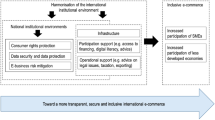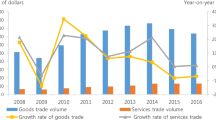Abstract
The study’s main purpose is to examine the impact of cross-border e-commerce factors such as e-taxation, e-trade policy, distance, gross domestic product, international restriction, antidumping and countervailing duties on exports of goods and services. This study provides a new perspective on cross-border e-commerce activities in Belt and Road countries of Asia using panel data econometric methodologies from 2000 to 2022. It contributes to our understanding of the role of cross-border e-commerce factors in improving the exports of goods and services in the Belt and Road countries of Asia. The panel data is also analysed by CD, CIPS, FMOLS, DOLS, and PMG-ARDL tests. This research has significant theoretical implications. As Belts and road countries increase spending on digital infrastructure and push for more international trade, cross-border e-commerce will likely become an increasingly important factor in their economies’ growth and participation in the international community. However, as per the findings of this study, all the factors statistically significantly impact exports of goods and services. The success of the Belt and Road program largely depends on the expansion and improvement of cross-border e-commerce in the region.


Similar content being viewed by others
Data availability
The datasets used and analyzed during the current study are available from the corresponding author upon reasonable request.
References
Akram-Shah, M., Hussain, M., & Gul, S. (2022). Development of A model for the in-service training of secondary school science teachers. Perennial Journal of History, 3(1), 49–68.
Ashraf, S. A., Siddiqui, A. J., Abd Elmoneim, O. E., Khan, M. I., Patel, M., Alreshidi, M., & Adnan, M. (2021). Innovations in nanoscience for the sustainable development of food and agriculture with implications on health and environment. Science of the Total Environment, 768(1), 144–155. https://doi.org/10.1016/j.scitotenv.2021.144990.
Banerjee, R., Gahan, P., Satpathy, S., & Dash, S. R. (2018). A study on cross border trade policies & developments with special reference to emerging economies. Espacios, 39(34), 11.
, Batool, S., Iqbal, J., Ali, A., & Perveen, B. (2022). Causal relationship between energy consumption, economic growth, and financial development: Evidence from South Asian countries. Journal of Environmental Science and Economics, 1(4), 61–76. https://doi.org/10.56556/jescae.v1i4.319.
Beeler, A., Aleks Schaefer, K., Sestak, J., & Conover, G. (2023). Impacts of U.S. countervailing duties on phosphate fertilizers. American Journal of Agricultural Economics, (1), 1—17. https://doi.org/10.1111/ajae.12401
Belloumi, M., & Touati, K. (2022). Do FDI inflows and ICT affect economic growth? An evidence from Arab countries. Sustainability, 14(10), 6293.
Błasiok, J. (2023). A unifying theory of distance from calibration. In Proceedings of the 55th Annual ACM Symposium on Theory of Computing (STOC 2023). Association for Computing Machinery, New York, NY, USA, 1727–1740. https://doi.org/10.1145/3564246.3585182.
Charmaine Mchunu, Vincent Chaplot (2012). Land degradation impact on soil carbon losses through water erosion and CO2 emissions. 177-178(none), 0–79. https://doi.org/10.1016/j.geoderma.2012.01.038.
Clayton, C., Antonio, C., Amanda Dos Santos, Matteo, M., & Jesse, S. (2023). China in Tax Havens. AEA Papers and Proceedings, 113: 114–19. https://doi.org/10.1257/pandp.20231001.
Cobley, D., & Bezzina, L. (2019). Disability and international development: A guide for students and practitioners. Disability & Society, 34(4), 670–672. https://doi.org/10.1080/09687599.2019.1574092
Gao, R., & Kleywegt, A. J. (2023). Distributionally robust stochastic optimization with Wasserstein distance. Mathematics of Operations Research, 48(2), 603–655. https://doi.org/10.1287/moor.2022.1275.
Ha, L. T., & Thanh, T. T. (2022). Effects of digital public services on trades in green goods: Does institutional quality matter? Journal of Innovation & Knowledge, 7(1), 100168. https://doi.org/10.1016/j.jik.2022.100168
M. Hashem Pesaran. (2004). General diagnostic tests for cross-sectional dependence in panels, Empirical Economics, Springer, vol. 60(1), pages 13–50, January.
M. Hashem Pesaran; Takashi Yamagata (2008). Testing slope homogeneity in large panels. , 142(1), 50–93. https://doi.org/10.1016/j.jeconom.2007.05.010.
Beatriz Galvão, A., & Mitchell, J. (2023). Real-time perceptions of historical GDP data uncertainty*. Oxford Bulletin of Economics and Statistics, 85(3), 457–481. https://doi.org/10.1111/obes.12542
Jalees, T., Qabool, S., Zaman, S. I., Kazmi, A., H, S., & Foroudi, P. (2021). Effect of spirituality and ethics on green advertising, and the multi-mediating roles of green buying and green satisfaction. Cogent Business & Management, 8(1), 1920559. https://doi.org/10.1080/23311975.2021.1920559.
Joakim Westerlund, David L. Edgerton (2007). A panel bootstrap cointegration test. Economics Letters, 97(3), 185–190. https://doi.org/10.1016/j.econlet.2007.03.003.
Kartal, M. T., Depren, S. K., Ayhan, F., & Depren, Ö. (2022). Impact of renewable and fossil fuel energy consumption on environmental degradation: Evidence from USA by Nonlinear approaches. International Journal of Sustainable Development & World Ecology, 29(8), 738–755. https://doi.org/10.1080/13504509.2022.2087115
Khan, I., & Hou, F. (2021). Does multilateral environmental diplomacy improve environmental quality? The case of the United States. Environmental Science and Pollution Research, 28(18), 23310–23322. https://doi.org/10.1007/s11356-020-12005-2
Koop, G., Mcintyre, S., Mitchell, J., & Poon, A. (2022). Reconciled estimates of monthly GDP in the US. Journal of Business & Economic Statistics, 41(2), 563–577. https://doi.org/10.1080/07350015.2022.2044336
Li, B., & Shan, H.-Z. (2017). The research of export enterprises implement the model of cross-border E-commerce strategy selection. 117(EEEIS 2016), pp. 129–34. https://doi.org/10.2991/eeeis-16.2017.17
Li, G., Zakari, A., & Tawiah, V. (2020). Does environmental diplomacy reduce CO2 emissions? A panel group means analysis. Science of the Total Environment, 722, 137790. https://doi.org/10.1016/j.scitotenv.2020.137790
Li, L. (2021). Digital transformation by SME entrepreneurs: A capability perspective digital transformation by SME entrepreneurs: A capability perspective. (November). https://doi.org/10.1111/isj.12153
Li, X., & Yang, L. (2023). Natural resources, remittances and carbon emissions: A Dutch disease perspective with remittances for South Asia. Resources Policy, 85, 104001. https://doi.org/10.1016/j.resourpol.2023.104001
Liu, A., Osewe, M., Shi, Y., Zhen, X., & Wu, Y. (2022). Cross-border e-commerce development and challenges in China: A systematic literature review. Journal of Theoretical and Applied Electronic Commerce Research, 17(1), 69–88. https://doi.org/10.3390/jtaer17010004
Liu, Z., & Li, Z. (2020). A blockchain-based framework of cross-border e-commerce supply chain. International Journal of Information Management, 52, 102059. https://doi.org/10.1016/j.ijinfomgt.2019.102059
Mathias, S., Sumudu, W., Ivanov, I. T., Kruttli, M. S., & Watugala, S. W. (2023). Banking on carbon: Corporate lending and cap- and-trade policy. https://doi.org/10.2139/ssrn.3650447.
Mensah, I. A., Sun, M., Gao, C., Omari-Sasu, A. Y., Zhu, D., Ampimah, B. C., & Quarcoo, A. (2019). Analysis on the nexus of economic growth, fossil fuel energy consumption, CO2 emissions and oil price in Africa based on a PMG panel ARDL approach. Journal of Cleaner Production, 228, 161–174. https://doi.org/10.1016/j.jclepro.2019.04.281
MOFCOM (Ministry of Commerce of the People's Republic of China) 2020. MOFCOM Order No 3 of 2020 on Rules on Handling Complaints of Foreign-Invested Enterprises August 31, 2020. https://english.www.gov.cn/archive/ministrydocument/202008/31/content_WS5f4eee54c6d0f7257693b6a1.html.
Ni, W., Fan, W., Lou, X., & Shao, S. (2019). Research on the International development of cross-border E-Commerce branding. Journal of Education and Praxis Research, 5(1), 1–12.
Nkendah, R. (2010, December). The informal cross-border trade of agricultural commodities between Cameroon and its CEMAC’s Neighbours. Paper for the NSF/AERC/IGC conference
Raihan, A., & Voumik, L. C. (2022). Carbon emission dynamics in India due to financial development, renewable energy utilization, technological innovation, economic growth, and urbanization. Journal of Environmental Science and Economics, 1(4), 36–50.
Sano, M., Cummings, J., Auer, S., Bergh, S., Fischer, C. E., Gerritsen, D., Grossberg, G., Ismail, Z., Lanctôt, K., Lapid, M. I., Mintzer, J., Palm, R., Rosenberg, P. B., Splaine, M., Zhong, K., & Zhu, C. W. (2023). Agitation in cognitive disorders: Progress in the International Psychogeriatric Association consensus clinical and research definition. International Psychogeriatrics 1–13. https://doi.org/10.1017/S1041610222001041
Sarfraz M, Ji X, Asghar M, Ivascu L, Ozturk I (2022) Signifying the Relationship between Fear of COVID-19, Psychological Concerns, Financial Concerns and Healthcare Employees Job Performance: A Mediated Model. International Journal of Environmental Research and Public Health, 19(5):2657. https://doi.org/10.3390/ijerph19052657.
Sencer Atasoy, B. (2017). Testing the environmental kuznets curve hypothesis across the U.S.: Evidence from panel mean group estimators. Renewable and Sustainable Energy Reviews, 77, 731–47. https://doi.org/10.1016/j.rser.2017.04.050
Shi, B., Gao, X., Jia, L., & Guo, X. (2019). The impact and countermeasures of new tax policy for cross-border e-commerce in China. World Customs Journal, 13(2), 3–16.
Silveira, D., Avelino, G., & Oliveira, S. (2021). Do antidumping measures increase market power? Evidence from Latin American countries. The International Trade Journal, 37(5), 457–480. https://doi.org/10.1080/08853908.2021.1992320
Tang, A. (2021). Cross-border data transfer and data localization requirements in China, ISACA, 1(1) 1–7. https://www.isaca.org/resources/news-and-trends/industry-news/2021/cross-border-data-transfer-and-datalocalization-requirements-in-china.
Thi, H., & Suri, H. (2021). The effects of cross-border E-commerce on international trade and economic growth: A case of China. International Journal of Economics and Finance, 13(12), 82–89. https://doi.org/10.5539/ijef.v13n12p82
Toska, A., & Fetai, B. (2023). The impact of E-commerce on the economic growth of the Western Balkan countries: A panel data analysis. International Journal of Sustainable Development and Planning, 18(3), 935–941. https://doi.org/10.18280/ijsdp.180329
Usman, A. (2019). An empirical assessment of the impact of E-commerce on value added tax revenue generation in Nigeria”. International Journal of Humanities and Social Science, 24(4), 6–17. https://doi.org/10.9790/0837-2404030617
Wang, Yu, Yi Wang, and Soo Hee Lee. (2017). The Effect of Cross-Border eCommerce on China’s International Trade: An Empirical Study Based on Transaction Cost Analysis. Sustainability (Switzerland) 9(11), 1–13. https://doi.org/10.3390/su9112028
Wang, G., & Cao, Z. (2021). An empirical study on the trade impact of cross border E-commerce on ASEAN and China under the framework of RECP. E3S Web of Conferences 275:2019–22. https://doi.org/10.1051/e3sconf/202127501039
Wang, H., & Liu, B. (2022). A role of production on E-commerce and foreign policy influencing one belt one road: mediating effects of international relations and international trade. Frontiers in Psychology, 12, 1–12. https://doi.org/10.3389/fpsyg.2021.793383
Wang, Yu., Wang, Yi., & Lee, S. H. (2017). The effect of cross-border e-commerce on China’s international trade: An empirical study based on transaction cost analysis. Sustainability (Switzerland), 9(11), 1–13. https://doi.org/10.3390/su9112028
Weili, L., Bibi, R., & Khan, I. (2022). Innovations, energy consumption and carbon dioxide emissions in the global world countries: An empirical investigation. Journal of Environmental Science and Economics, 1(4), 12–25. https://doi.org/10.56556/jescae.v1i4.288.
Westerlund, J. (2007), Testing for rerror correction in panel data†. Oxford Bulletin of Economics and Statistics, 69, 709–748. https://doi.org/10.1111/j.1468-0084.2007.00477
Yang, C. (2022). Cross-border expansion of digital platforms and transformation of the trade and distribution networks of imported fresh fruits from Southeast Asia to China. Global Networks, 22, 716–734. https://doi.org/10.1111/glob.12352.
Yin, Z. H., & Choi, C. H. (2021). The effects of China’s cross-border e-commerce on its exports: A comparative analysis of goods and services trade. Springer US.
Zang, X., Adebayo, T. S., Oladipupo, S. D., & Kirikkaleli, D. (2023). Asymmetric impact of renewable energy consumption and technological innovation on environmental degradation: Designing an SDG framework for developed economy. Environmental Technology, 44(6), 774–791. https://doi.org/10.1080/09593330.2021.1983027
Acknowledgements
The authors extend their heartfelt thanks to the editorial board and the anonymous reviewers for their valuable suggestions.
Author information
Authors and Affiliations
Corresponding author
Ethics declarations
Competing interests
The authors declare no competing interests.
Funding
There is no specific Funding for this study.
Consent for publication
Not applicable.
Additional information
Publisher's Note
Springer Nature remains neutral with regard to jurisdictional claims in published maps and institutional affiliations.
Rights and permissions
Springer Nature or its licensor (e.g. a society or other partner) holds exclusive rights to this article under a publishing agreement with the author(s) or other rightsholder(s); author self-archiving of the accepted manuscript version of this article is solely governed by the terms of such publishing agreement and applicable law.
About this article
Cite this article
Han, B., Rizwanullah, M., Luo, Y. et al. The role of cross-border E-commerce on the export of goods and services. Electron Commer Res (2024). https://doi.org/10.1007/s10660-024-09818-5
Accepted:
Published:
DOI: https://doi.org/10.1007/s10660-024-09818-5




